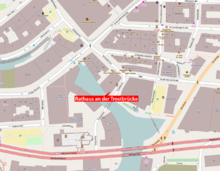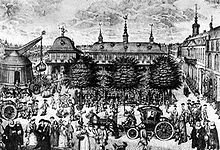Town hall at the Trostbrücke
| Town hall at the Trostbrücke | |
|---|---|
 Exterior view of the town hall at the Trostbrücke. |
|
| Data | |
| place | Hamburg |
| Construction year | Original construction before 1292, last construction mainly 1599–1649 |
| Coordinates | 53 ° 32 '54.9 " N , 9 ° 59' 33" E |
The town hall on the Trostbrücke (also known as the Latin consistorium ) was the seat of the citizenship and the council or senate of the Free and Hanseatic City of Hamburg from 1290 to 1842 . It was destroyed in the great fire in 1842. In its place today stands the house of the Patriotic Society from 1765 (built 1845–1847), which also served as a meeting place for the citizens for some time until the inauguration of today's Hamburg City Hall in 1897.
history
The town hall on Neß an der Trostbrücke was built around 1290. The footprint of this brick building including the two-storey hall was 26 × 17 meters. Numerous structural changes have been made over the years. A Renaissance extension was built next to the Niedergericht at the beginning of the 17th century . In 1619 the Hamburg bank moved in . This economic and political center of Hamburg was blown up in 1842 to stop the fire from the Hamburg fire . Some of the statues of German emperors that were inserted on the facade of this town hall since 1640 have been preserved and can now be seen on the outer facade of the Museum of Hamburg History . Silver bars from the silver treasure fused with fire rubble are also on display in the Phoenix Hall of the town hall.
The construction of this town hall required the demolition of several buildings, the foundations of which were exposed after the Hamburg fire of 1842. These foundations made of trass mortar and clinker brickwork were clad with granite blocks on the side facing the Alster . In addition, a large number of piles were uncovered that did not fit the floor plan of the town hall and therefore must have belonged to other, older buildings.
The exact year of construction of the town hall on the Trostbrücke is not known. Nevertheless, various indications help to narrow down this period. A view of the town hall published between 1681 and 1701 by Peter Schenck the Elder gives the year 1276 as the year of construction ( Het Rathuis gebout in het Jaar 1276: na der hant in het Jaar vergroot en vernieut ) and von Hövelen in: Some etc. The city of Hamburg has strangely useful memories, etc. 1668 mentions page 9: "After the good news has been obtained, it is reported here how two town halls in Hamburg that were first intended in 1276 were drawn into one, and only one thing bank (Geter Schenrichtshaus) was built up." The town hall at the Trostbrücke can only be proven for the year 1292, when Johannes Seinkel left the Hamburg chapter a pension of 11 marks and 110 pfennigs for the town hall near the Trostbrücke. The town hall on the Trostbrücke is mentioned for the first time for 1350 and 1351 in "Der Stadt Hamburg Erbe- und Rente-Buch".
The dimensions of the building are described as 89 feet (front), 62 1/2 feet (south side), 58 1/2 feet (north side) and 87 3/4 feet (water side). It should be noted that a hamburger foot corresponds to 286.5715 mm. This results in the following dimensions in meters: 25.504 m × 17.911 m × 16.764 m × 25.147 m. The brick building has only been documented in graphs since the 17th century. The existing representations are usually neither true to scale nor true to detail. The oldest view of the town hall can be found on a copper engraving depicting the Hamburg Stock Exchange by the Dutchman Jan Dircksen from Campen, who lived in Hamburg since at least 1613. The 17 × 11 inch copper engraving shows sixteen German verses by PMA JC at the bottom. The town hall is only shown in section, but shows the portal in its original form.
In addition to this depiction, there is another copper engraving of the entire town hall by Hieronimus von Henßbergen (probably from 1677) - 18 1/2 inches wide and 14 1/2 inches high - depicting Caspar Hasse's Fontaine and art master, new Schlangen-Brandt -Syringe. The actual number of windows differs from the number shown on this version.
In 1599, a residential building north of the town hall was demolished and an extension was built on its area from 1601. The three-storey extension was expanded in 1649. Both new buildings were aligned with a uniform facade design and provided with ridge turrets. In 1649 a small tower was built on the roof at the height of the dividing wall between the two buildings, in which a clock was attached. In 1651 the Hamburger Bank moved into the rooms on the ground floor of the extension building.
architecture
Some of the components of the old town hall could be saved from destruction; they were stored for a few years and were then taken in by Fritz Schumacher as architectural fragments during the construction of the Museum of Hamburg History in its exhibition and outside area .
Portal of the small town hall door
The portal formed the "small" town hall door to the extension of the town hall at the Trostbrücke from 1601. Only the sculptural decoration, the columns and the central rosette with the city coat of arms, which are in the Museum of Hamburg History, have survived from the original .
The elaborately crafted portal has various architectural elements. The two lateral, fluted , Corinthian columns hold the archway and are the main components of the portal. Two geniuses of peace with palm branches are depicted in the spandrels of the archway. The architrave is adorned with a medallion-like depiction of the Hamburg city arms , which is supported by two lions standing on their hind legs. Next to the lions there is a male figure with a spear in Roman costume. At the top of the portal (above the coat of arms) stands the goddess of peace, holding a wreath in her raised right hand.
Portal of the extension from 1649
The portal was on the extension of the town hall from 1649 and led to the Hamburger Feuerkasse and the Hamburger Bank, which was on the ground floor of the extension. In the spandrels of the portal there are two lions holding the Hamburg city arms in the middle. The original arch of the portal is still preserved, which is attached to the right of the facade in the entrance area of the Museum of Hamburg History on reconstructed pilasters . Inside the arch on the museum facade was the normal time clock of the Hamburg observatory , which was located in front of the museum building at this location.
Door knocker on the main gate
Imperial figures
In the first half of the 17th century, the medieval town hall building was expanded with two additions in the style of the Dutch Renaissance . In the facade of the annex from 1601 and its extension in 1649, a total of 21 statues were set in niches that represented emperors of the Holy Roman Empire . The first 15 statues on the extension from 1601 showed emperors who were particularly important for Hamburg's history. The figures on its expansion in 1649 represented the 6 emperors who last ruled in the Holy Roman Empire of the German nation.
The statues manifested Hamburg's claim to imperial immediacy , i. H. the direct subordination to the emperor, and consequently the rejection of all other claims that were made, for example, by the Danish king, as the legal successor to the extinct Counts of Schauenburg .
When exactly the individual statues were created cannot be clearly inferred from the literature. Most sources report that the first 15 statues were added when the annex was built in 1601. Gaedechens writes, however, that all statues were created in 1649 when the facade of the new town hall and the town hall extension were standardized.
After the town hall on Trostbrücke was blown up in 1842, 20 of the 21 statues that were subsequently inserted by Fritz Schumacher in the north side of the Museum of Hamburg History were saved . 6 of these statues were so badly damaged by bombs during the Second World War that they could not be re-erected.
Today the following statues can be seen on the north side of the museum: In the upper row from left to right: Charlemagne , Ludwig the Pious , Heinrich I and Otto I. In the lower row from left to right: Otto II. , Konrad II. , Lothar von Sachsen , Friedrich Barbarossa , Karl IV. , Sigismund , Albrecht II. , Friedrich III. , Maximilian II and Charles V.
Main portal
The main portal received two sculptures and a coat of arms created by the Swedish sculptor Johann Wilhelm Manstadt in 1772 .
See also
literature
- Friedrich Georg Buek : Hamburg antiquities: Contribution to the history of the city and its customs . Perthes-Besser & Mauke, Hamburg 1859, p. 68-78, 239-240 ( online [accessed October 17, 2012]).
- Cipriano Francisco Gaedechens : History of the Hamburg town hall: after the preparatory work left behind by Johann Martin Lappenberg . Ed .: Association for Hamburg History. Meißner, Hamburg 1867, p. 18 ( online [accessed October 17, 2012]).
- Wilhelm Jesse among others: Guide through the Museum of Hamburg History . Alster-Verlag, Hamburg 1926, p. 9 .
- Theodor Schrader : Guide through the Museum of Hamburg History . 7th edition. Lütcke & Wulff, Hamburg 1908, p. 9 .
- Hildamarie Schwindrazheim : Sculpture in Hamburg from the first half of the seventeenth century: III . In: Journal of the Association for Hamburg History . No. 32 , 1931, ISSN 0083-5587 , p. 167-196, here 185-186 .
- Hildamarie Schwindrazheim : Sculpture in Hamburg from the first half of the seventeenth century: IV . In: Journal of the Association for Hamburg History . No. 33 , 1933, ISSN 0083-5587 , p. 157-187, here 185-186 .
- Ferdinand Stöter : To the town hall building . Gräfe, Hamburg 1875 ( online [accessed October 17, 2012]).
- Alexander Birt : The great Hamburg fire, and what it destroyed us in the old town hall: art, architectural and local history from the time between Hamburg's two city fires from 1284 to 1842 . Gräfe & Sillem, Hamburg 1892 ( online [accessed October 17, 2012]).
- Anne-Kathrin Rehm: Secrets of a museum building - architectural decorations at the Museum of Hamburg History - a tour with 8 stations . Hamburg 1994.
Web links
- The town hall on the Trostbruecke on lexikus.de
- House on the Trostbrücke on the Patriotic Society from 1765
Individual evidence
- ^ Cipriano Francisco Gaedechens : History of the Hamburg town hall: after the preparatory work left by Johann Martin Lappenberg . Ed .: Association for Hamburg History. Meißner, Hamburg 1867, p. Panel I ( online [accessed October 17, 2012]).
- ↑ Symbols: p. 8 f.
- ↑ Symbols: p. 9
- ↑ Symbols: p. 8 f.
- ↑ Gaedechens: p. 21
- ^ Rehm: o. P.
- ^ Rehm: o. P.








